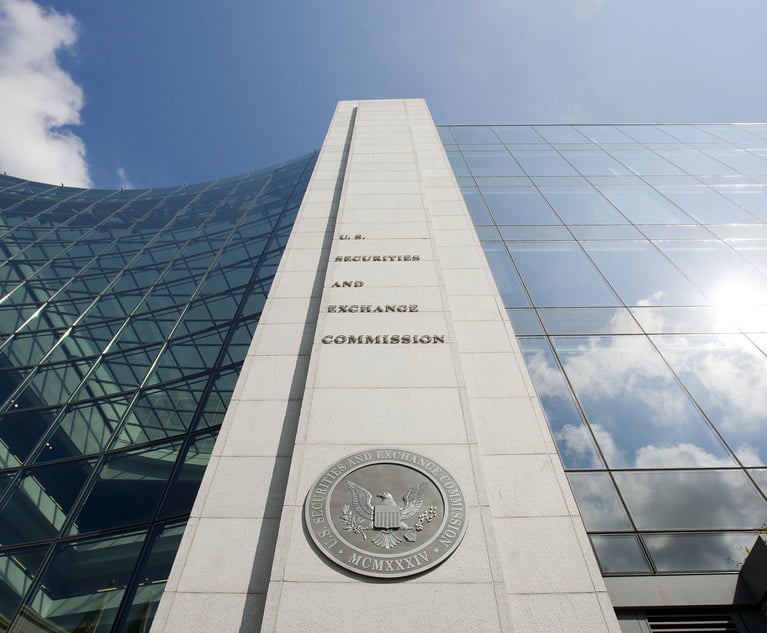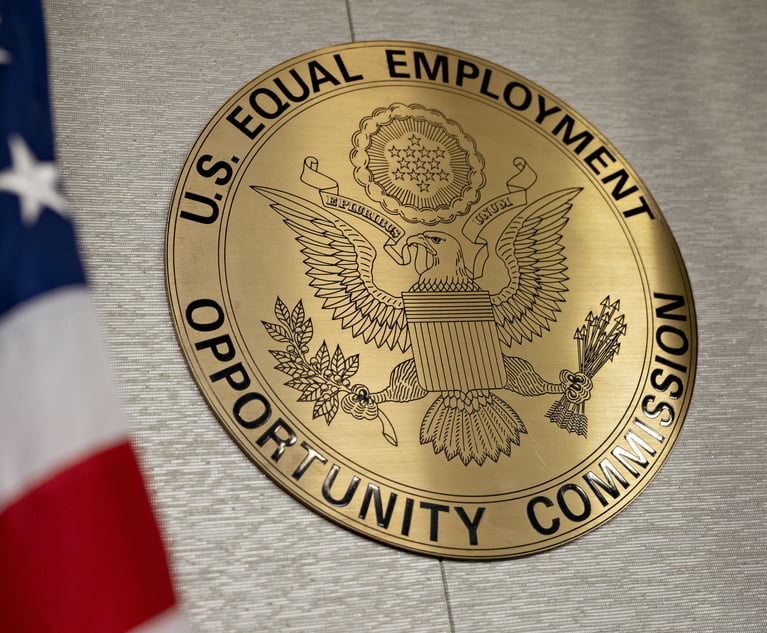High Court Forces EPA to Regulate Utilities
When Janet Reno and former EPA chief Carol Browner began suing coal-burning power companies in the final months of the Clinton administration, they sparked a legal battle that still rages today in the federal courts.
May 31, 2007 at 08:00 PM
13 minute read
When Janet Reno and former EPA chief Carol Browner began suing coal-burning power companies in the final months of the Clinton administration, they sparked a legal battle that still rages today in the federal courts.
The most recent skirmish was decided in the U.S. Supreme Court in April when the court unanimously rejected a 4th Circuit ruling in Environmental Defense v. Duke Energy. The decision was a setback for Duke and other power companies that hoped the court would affirm the 4th Circuit's decision to invalidate the EPA's net-annual emissions test, used to determine whether a physical change to an existing power plant subjects that plant to the Clean Air Act's (CAA) standards for new sources of pollution.
“This decision emphatically puts to rest a pivotal legal defense that has been percolating in the lower courts for years,” says Vickie Patton, a senior attorney with Boulder, Colo.-based non-profit Environmental Defense. “The court clarified that if you change a facility in a way that increases actual air pollution, you are subject to the rules requiring installation of modern pollution controls.”
Major Modification
The Clean Air Act requires newly built power plants to use the best technology available to minimize emissions of such pollutants as sulfur dioxide, nitrogen oxide and fine particles. To ease the transition to the new requirements, Congress exempted existing facilities from these New Source Performance Standards (NSPS), allowing old plants to continue operating under their old permits.
But that exemption came with a catch: the law included in its definition of “new source” any existing facility with a “modification ?? 1/2 which increases the amount of any air pollutant emitted.” Congress included this language to prevent power providers from refurbishing old facilities without making environmental protection upgrades.
However, EPA and the CAA define the term “modification” in multiple ways, and this lack of clarity has fueled conflict. Duke and some other utilities have interpreted the term in accordance with the NSPS provisions of the CAA, which describe changes that increase a plant's hourly emissions rate. Thus between 1988 and 2000, at eight power plants in the Carolinas, Duke replaced many worn-out components, including boiler tubes and ignition systems. It reasoned that it did not have to upgrade its emissions controls because hourly emissions from the plants did not increase.
“We considered it routine maintenance to keep the plants operating,” says Tom Williams, a Duke Energy spokesman. “We did this at virtually all of our coal-fired power plants, and … the EPA knew what we were doing.”
EPA, however, applied a different definition of “modification.” Specifically, EPA's Prevention of Significant Deterioration (PSD) regulations define it as any physical change resulting in more annual emissions than the average emitted in the previous two years. By this definition Duke's refurbished power plants–which were now capable of operating for longer hours–were new sources of pollution.
EPA sued Duke in December 2000, alleging 58 ongoing violations of PSD permit requirements, and argued the company must stop operating the affected plants until it installs the latest pollution-control technology–at a cost likely to force many of the 1950s-vintage plants into retirement. Additionally, EPA said Duke is liable for hundreds of millions of dollars in possible penalties.
“The case illuminates the problem EPA's new-source review program presents,” says Lewis Putman, a partner at Milbank, Tweed, Hadley & McCloy. “It's a complicated, confusing, very difficult program for utilities to deal with.”
Agency Discretion
Duke asked the district court for summary judgment on the basis EPA was using the wrong definition of “modification.” The court agreed, ruling in 2003 that the agency's definition was inconsistent with statutes. EPA appealed to the 4th Circuit, which affirmed in 2005.
EPA accepted the 4th Circuit's ruling–and in fact had already drafted new regulations that would exempt equipment replacements from the definition of “modification.” But EPA's co-plaintiffs, Environmental Defense and other advocacy groups, appealed to the Supreme Court.
The High Court focused on two questions–how EPA's regulations should define “modification,” and whether the courts could legally invalidate EPA's regulations. The High Court resolved both questions in favor of the plaintiffs.
First, it said the lower courts read the statutory language too narrowly. “The 1980s PSD regulations may be no seamless narrative, but they clearly do not define a 'major modification' in terms of an increase in the hourly emissions rate,” wrote Justice David Souter. “EPA's construction need do no more than fall within the limits of what is reasonable.”
Second, the court said the 4th Circuit didn't have jurisdiction to invalidate EPA's regulations. Under CAA ?? 1/2 307(b), only the D.C. Circuit can hear a challenge to EPA rules, and even then can only do so within 60 days of the rulemaking.
The immediate effect of the decision is a victory for environmental advocates because it preserves the annual-net emissions test. But that doesn't mean Duke's battle is lost. On remand the company plans to argue its plant changes were not modifications but routine maintenance, and EPA violated due process by issuing standards without fair notice.
“This is not about the environment,” Williams says. “It's about how we maintain our plants. We are seeking clarity going forward on how to maintain our facilities so we won't get second guessed.”
In the longer term, the decision bolsters EPA's authority to implement environmental laws and ultimately encourages policy efforts toward more flexible rules. “The opinion on the agency's discretion was strong,” Putman says. “The court is inviting EPA to continue reforming a program that is dysfunctional. That could be a positive outcome for regulated companies.”
When Janet Reno and former EPA chief Carol Browner began suing coal-burning power companies in the final months of the Clinton administration, they sparked a legal battle that still rages today in the federal courts.
The most recent skirmish was decided in the U.S. Supreme Court in April when the court unanimously rejected a 4th Circuit ruling in Environmental Defense v.
“This decision emphatically puts to rest a pivotal legal defense that has been percolating in the lower courts for years,” says Vickie Patton, a senior attorney with Boulder, Colo.-based non-profit Environmental Defense. “The court clarified that if you change a facility in a way that increases actual air pollution, you are subject to the rules requiring installation of modern pollution controls.”
Major Modification
The Clean Air Act requires newly built power plants to use the best technology available to minimize emissions of such pollutants as sulfur dioxide, nitrogen oxide and fine particles. To ease the transition to the new requirements, Congress exempted existing facilities from these New Source Performance Standards (NSPS), allowing old plants to continue operating under their old permits.
But that exemption came with a catch: the law included in its definition of “new source” any existing facility with a “modification ?? 1/2 which increases the amount of any air pollutant emitted.” Congress included this language to prevent power providers from refurbishing old facilities without making environmental protection upgrades.
However, EPA and the CAA define the term “modification” in multiple ways, and this lack of clarity has fueled conflict. Duke and some other utilities have interpreted the term in accordance with the NSPS provisions of the CAA, which describe changes that increase a plant's hourly emissions rate. Thus between 1988 and 2000, at eight power plants in the Carolinas, Duke replaced many worn-out components, including boiler tubes and ignition systems. It reasoned that it did not have to upgrade its emissions controls because hourly emissions from the plants did not increase.
“We considered it routine maintenance to keep the plants operating,” says Tom Williams, a
EPA, however, applied a different definition of “modification.” Specifically, EPA's Prevention of Significant Deterioration (PSD) regulations define it as any physical change resulting in more annual emissions than the average emitted in the previous two years. By this definition Duke's refurbished power plants–which were now capable of operating for longer hours–were new sources of pollution.
EPA sued Duke in December 2000, alleging 58 ongoing violations of PSD permit requirements, and argued the company must stop operating the affected plants until it installs the latest pollution-control technology–at a cost likely to force many of the 1950s-vintage plants into retirement. Additionally, EPA said Duke is liable for hundreds of millions of dollars in possible penalties.
“The case illuminates the problem EPA's new-source review program presents,” says
Agency Discretion
Duke asked the district court for summary judgment on the basis EPA was using the wrong definition of “modification.” The court agreed, ruling in 2003 that the agency's definition was inconsistent with statutes. EPA appealed to the 4th Circuit, which affirmed in 2005.
EPA accepted the 4th Circuit's ruling–and in fact had already drafted new regulations that would exempt equipment replacements from the definition of “modification.” But EPA's co-plaintiffs, Environmental Defense and other advocacy groups, appealed to the Supreme Court.
The High Court focused on two questions–how EPA's regulations should define “modification,” and whether the courts could legally invalidate EPA's regulations. The High Court resolved both questions in favor of the plaintiffs.
First, it said the lower courts read the statutory language too narrowly. “The 1980s PSD regulations may be no seamless narrative, but they clearly do not define a 'major modification' in terms of an increase in the hourly emissions rate,” wrote Justice David Souter. “EPA's construction need do no more than fall within the limits of what is reasonable.”
Second, the court said the 4th Circuit didn't have jurisdiction to invalidate EPA's regulations. Under CAA ?? 1/2 307(b), only the D.C. Circuit can hear a challenge to EPA rules, and even then can only do so within 60 days of the rulemaking.
The immediate effect of the decision is a victory for environmental advocates because it preserves the annual-net emissions test. But that doesn't mean Duke's battle is lost. On remand the company plans to argue its plant changes were not modifications but routine maintenance, and EPA violated due process by issuing standards without fair notice.
“This is not about the environment,” Williams says. “It's about how we maintain our plants. We are seeking clarity going forward on how to maintain our facilities so we won't get second guessed.”
In the longer term, the decision bolsters EPA's authority to implement environmental laws and ultimately encourages policy efforts toward more flexible rules. “The opinion on the agency's discretion was strong,” Putman says. “The court is inviting EPA to continue reforming a program that is dysfunctional. That could be a positive outcome for regulated companies.”
This content has been archived. It is available through our partners, LexisNexis® and Bloomberg Law.
To view this content, please continue to their sites.
Not a Lexis Subscriber?
Subscribe Now
Not a Bloomberg Law Subscriber?
Subscribe Now
NOT FOR REPRINT
© 2025 ALM Global, LLC, All Rights Reserved. Request academic re-use from www.copyright.com. All other uses, submit a request to [email protected]. For more information visit Asset & Logo Licensing.
You Might Like
View All

‘Extremely Disturbing’: AI Firms Face Class Action by ‘Taskers’ Exposed to Traumatic Content
5 minute read
In-House Lawyers Are Focused on Employment and Cybersecurity Disputes, But Looking Out for Conflict Over AI
Trending Stories
- 1Pa. High Court: Concrete Proof Not Needed to Weigh Grounds for Preliminary Injunction Order
- 2'Something Else Is Coming': DOGE Established, but With Limited Scope
- 3Polsinelli Picks Up Corporate Health Care Partner From Greenberg Traurig in LA
- 4Kirkland Lands in Phila., but Rate Pressure May Limit the High-Flying Firm's Growth Prospects
- 5Davis Wright Tremaine Turns to Gen AI To Teach Its Associates Legal Writing
Who Got The Work
J. Brugh Lower of Gibbons has entered an appearance for industrial equipment supplier Devco Corporation in a pending trademark infringement lawsuit. The suit, accusing the defendant of selling knock-off Graco products, was filed Dec. 18 in New Jersey District Court by Rivkin Radler on behalf of Graco Inc. and Graco Minnesota. The case, assigned to U.S. District Judge Zahid N. Quraishi, is 3:24-cv-11294, Graco Inc. et al v. Devco Corporation.
Who Got The Work
Rebecca Maller-Stein and Kent A. Yalowitz of Arnold & Porter Kaye Scholer have entered their appearances for Hanaco Venture Capital and its executives, Lior Prosor and David Frankel, in a pending securities lawsuit. The action, filed on Dec. 24 in New York Southern District Court by Zell, Aron & Co. on behalf of Goldeneye Advisors, accuses the defendants of negligently and fraudulently managing the plaintiff's $1 million investment. The case, assigned to U.S. District Judge Vernon S. Broderick, is 1:24-cv-09918, Goldeneye Advisors, LLC v. Hanaco Venture Capital, Ltd. et al.
Who Got The Work
Attorneys from A&O Shearman has stepped in as defense counsel for Toronto-Dominion Bank and other defendants in a pending securities class action. The suit, filed Dec. 11 in New York Southern District Court by Bleichmar Fonti & Auld, accuses the defendants of concealing the bank's 'pervasive' deficiencies in regards to its compliance with the Bank Secrecy Act and the quality of its anti-money laundering controls. The case, assigned to U.S. District Judge Arun Subramanian, is 1:24-cv-09445, Gonzalez v. The Toronto-Dominion Bank et al.
Who Got The Work
Crown Castle International, a Pennsylvania company providing shared communications infrastructure, has turned to Luke D. Wolf of Gordon Rees Scully Mansukhani to fend off a pending breach-of-contract lawsuit. The court action, filed Nov. 25 in Michigan Eastern District Court by Hooper Hathaway PC on behalf of The Town Residences LLC, accuses Crown Castle of failing to transfer approximately $30,000 in utility payments from T-Mobile in breach of a roof-top lease and assignment agreement. The case, assigned to U.S. District Judge Susan K. Declercq, is 2:24-cv-13131, The Town Residences LLC v. T-Mobile US, Inc. et al.
Who Got The Work
Wilfred P. Coronato and Daniel M. Schwartz of McCarter & English have stepped in as defense counsel to Electrolux Home Products Inc. in a pending product liability lawsuit. The court action, filed Nov. 26 in New York Eastern District Court by Poulos Lopiccolo PC and Nagel Rice LLP on behalf of David Stern, alleges that the defendant's refrigerators’ drawers and shelving repeatedly break and fall apart within months after purchase. The case, assigned to U.S. District Judge Joan M. Azrack, is 2:24-cv-08204, Stern v. Electrolux Home Products, Inc.
Featured Firms
Law Offices of Gary Martin Hays & Associates, P.C.
(470) 294-1674
Law Offices of Mark E. Salomone
(857) 444-6468
Smith & Hassler
(713) 739-1250







